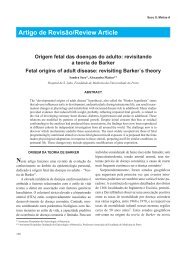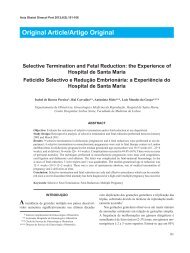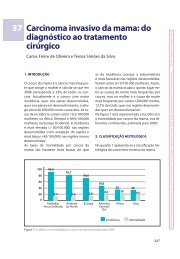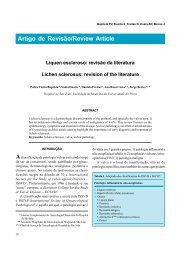376\377\000E\000B\000G\000B\000-\0002\000 \000p\000a\000r ...
376\377\000E\000B\000G\000B\000-\0002\000 \000p\000a\000r ...
376\377\000E\000B\000G\000B\000-\0002\000 \000p\000a\000r ...
Create successful ePaper yourself
Turn your PDF publications into a flip-book with our unique Google optimized e-Paper software.
Acta Obstet Ginecol Port 2008;suppl 1<br />
“See and treat” rates were 60.7% for moderate<br />
dysplasia, and 56.4 % for severe dysplasia. Most patients<br />
with Moderate and severe dysplasia on Cervical smear<br />
showed CIN2 and CIN3 respectively on histological<br />
analysis. Only 18.2% of patients with moderate dysplasia<br />
and 8.9% of patients with Severe dysplasia justifed “first<br />
biopsy” management. There appeared to be a higher<br />
tendency for “first biopsy” in younger patients.<br />
Only 6 out of 64 patients with “incomplete excision” on<br />
LLETZ had positive cervical smears on subsequent 12<br />
month follow up. These included 3 with borderline, 1 with<br />
moderate and 2 with severe dyskaryosis on follow up<br />
smears.<br />
Conclusions: There is a need for an increase in “See<br />
and treat” patients. Conservative “biopsy first” is not<br />
justified unless the clinical picture and findings at<br />
Colposcopy indicate otherwise. Cytology correlates well<br />
with Histology except in Borderline and to an extent<br />
mild dysplasia on Cervical Smears. Patients with<br />
incomplete excision do well; however caution is needed<br />
as high grade lesions can be detected at a later stage.<br />
314<br />
Endometrial stromal tumours - the<br />
experience of the Division of Gynecology<br />
of Hospital S. Marcos (Portugal) from<br />
1991-2007<br />
Diogo Cunha 1 , Cátia Abreu 1 , Teresa Ramos 1 , Paula<br />
Serrano 1 , Pedro Cabrita 1<br />
1 Hospital S.Marcos, Portugal<br />
Introduction: Endometrial stromal tumours (EST) are<br />
rare tumours that occur primarily in perimenopausal<br />
women.<br />
Material and methods: Retrospective study of 8 cases<br />
of EST occurred between Jan 1991 – Sep 2007 in the<br />
Division of Gynecology of Hospital S. Marcos. Statistical<br />
analysis involved SPSS® 15.0 version.<br />
Results: The 8 cases of EST correspond to 4,1% of all<br />
primary uterine corpus malignancies (n=193) occurred in<br />
that time-span in our institution. The 3 types of EST<br />
observed were low-grade endometrial stromal sarcoma<br />
(50%), undifferentiated endometrial sarcoma (37,5%) and<br />
stromal nodule (12,5%). Mean-age of presentation was<br />
52,2 ± 10.8 years and these neoplasms were usually<br />
diagnosed (87,5%) in stage I disease of FIGO classification.<br />
Management of EST was always surgical, complemented<br />
with adjuvant therapies in 50% (n=4) of cases, being<br />
radiation therapy alone in one half of these (n=2) and<br />
radiation therapy + chemotherapy in the other half. One<br />
patient’s contact was lost during follow-up, nevertheless<br />
global mean time of follow-up was 7,0 ± 5,2 years.<br />
Recurrence of the malignancy was detected in 14,3% (n=1)<br />
of the cases. The global 5-year survival rate was 53%.<br />
114<br />
Conclusion: Although being a small series, this study<br />
reproduces the knowledge about endometrial stromal<br />
tumours that’s available in literature. The majority of EST<br />
presented initially as stage I disease but the 5-year<br />
survival was only 53% reflecting the aggressive nature<br />
of these neoplasms. We observed a lesser rate of<br />
recurrence of tumours than in the literature (14,3% vs<br />
50%) perhaps due to the short period of follow-up that<br />
some patients still have.<br />
334<br />
Germ cell ovarian tumors with malignant<br />
potential casuistic of the Division of<br />
Gynecology, S. Marcos Hospital<br />
Portugal (1990-2006)<br />
Cátia Abreu 1 , Diogo Cunha 1 , Teresa Ramos 1 ,<br />
Pedro Cabrita 1 , Paula Serrano 1<br />
1 Hospital S. Marcos, Portugal<br />
Introduction: Germ cell tumors represent 20 to 25% of<br />
all ovarian neoplasms, but only 3% are malignant. These<br />
tumors occur mainly in young women, which involves<br />
decisions concerning specially childbearing. Advances<br />
in chemotherapy have modified the prognosis of different<br />
types of germ cell tumors.<br />
Material and methods: Retrospective study of<br />
seventeen cases of germ cell ovarian tumors with malignant<br />
potential occurred between January 1990 and December<br />
2006, with particular attention to clinical profile, staging,<br />
treatment options and follow-up. The statistical analysis<br />
was performed using SPSS for Windows, version 15.0.<br />
Results: Seventeen cases (9,9%) of germ cell tumors<br />
with malignant potential were reviewed, representing 2,7%<br />
of all gynecologic tumors diagnosed in S. Marcos Hospital<br />
– Braga, in a 16-year period. The average age of incidence<br />
was 37,9 (14-83) years, with the most affected group<br />
ranging from 10 to 30 years (41,2%). The histological<br />
types verified were immature teratomas (47,1%), struma<br />
ovarii (17,6%) dysgerminomas (11,8%), and also 11,8%<br />
of mature cystic teratoma with malignant transformation<br />
(both with development of squamous cell carcinoma).<br />
Most teratomas were diagnosed grade II tumors, although<br />
reported one case of grade III with gliomatosis peritonei.<br />
All struma carcinoids were stage Ia at diagnosis;<br />
dysgerminomas were stage Ic, one of them occurring in<br />
a pregnant patient at the first trimester. The initial approach<br />
to most of these germ cell malignancies had been<br />
unilateral oophorectomy and proper surgical staging.<br />
Chemotherapy with BEP regimens was used for treatment<br />
of grade II and III immature teratomas, and a second-look<br />
laparotomy was performed in a patient with grade II tumor.<br />
One dysgerminoma was treated with chemotherapy; the<br />
other one with radiation therapy, which led to fertility<br />
problems. The 5-year and 10-year survival rates were









